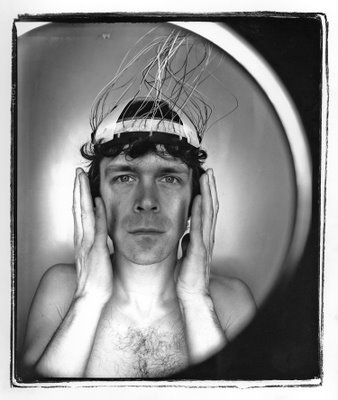Banging My Own Drum With One Light
Sunday, December 14, 2008

As my job (formerly a profession) as a magazine photographer fades away asymptote-like, I find some small comfort that unlike General Douglas MacArthur I cannot be fired. I am a free lancer. But like him I am fading away as quickly as a poorly fixed photograph. It is a photograph that will become plain dust and not a random dissolution of pixels. Meanwhile I must feed my wife her hot cream-of-wheat with brown sugar in the morning so I need funds. Some of them come from my teaching endeavours. I teach at two places. One is Focal Point and the other is Van Arts. The former has a full-times students program like the latter but it also has photo workshops and 10-week courses. That's where I come in. In the last The Contemporary Portrait Nude class (mentioned here I had 6 students. This was an especially fun and intimate class but not one that will make money for the school. I offered to write an essay promoting my next class The One Light Portrait Photography Course for their Christmas brochure as the class begins in January. Perhaps if enough people read that essay we may get that sweet sum of 12 students, not too big, not too small. The school has two studios joined by doors. I divide my class in two so that in the three-hour shooting sessions there is plenty of time to take pictures. The essay is accompanied by my photograph of Vancouver actor/director Paul Terns which I shot with one ring light.
The One Light Portrait Photography Course
Alex Waterhouse-Hayward
Those who work at Focal Point have a standing joke on the two classes that I teach there. They say one is One Light, No Clothes and the other One Light With Clothes. Joke aside they are completely right. As a magazine photographer in Vancouver for 35 years a great majority of my photographs have been one light photographs. And most recently I have further fine tuned my choice to a 2x3 ft soft box placed very close to my subject while standing near a middle gray wall.
In most situations with the exception of my frequent use of a powerful ring flash, that light has never been an on-camera flash. And therein is the problem as to why so many photographs on the internet in such social sites like Flickr and myspace all tend to look the same. The pictures were either taken with existing light or with an on camera pop-up flash.
The Holy Grail of photography for any photographer with gumption should be to find a personal style. Tethering a camera to a modified light (via either a flash cord or a radio slave) such as a soft box or an umbrella mostly happens in the professional photographer’s studio. These kinds of photographs are becoming less frequent. Learning how to use a modified one light is one way, I believe, of rapidly increasing one’s chances of successfully pursuing that elusive personal style.
The 19th century was limited until almost its end, with photography that depended on existing natural light. As soon as electric lights came in photographers and cinematographers were hampered by slow film emulsion. The bright focused lights they used produced the glamorous and mysterious film noir films of the 30 to the 50s. Then this kind of light went out of fashion and a more uniform natural light (still with powerful light units) came into use. Only recently, as digital still camera and digital cinematography cameras have been developed with ultra sensitive sensors, has it been possible to use them in low light situations without additional lighting. In fact Vancouver Sun film critic, Katherine Monk while reviewing Jonathan Demme’s Rachel Getting Married notes that the film is “Shot on high-definition digital video with little or no apparent artificial light…” To me this means that this will be a gritty film with no lighting style. And that is fine. But when you pay good money to escape financial depression and working angst is this what you need? Is it coincidence that the age of Hollywood glamour films occurred during the Great Depression? Is Rachel Getting Married a trend in more unlit digital films? Will movies soon resemble the images of Flickr?
Choosing to take photographs with no additional lighting should be a choice based on purpose while knowing what the other possibilities are. Learning to use one light, be it a soft box, an open flash, a ring flash, a spotlight or a grid spot light should be part of any photographer’s recipe book towards photographic diversity and the achievement of a personal style.
The class runs Tuesdays from 2-5pm beginning January 13






